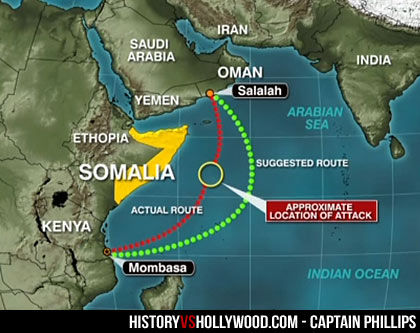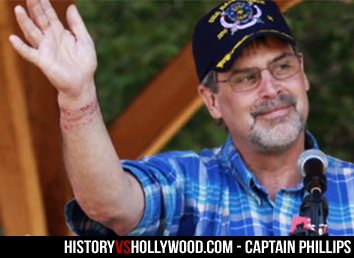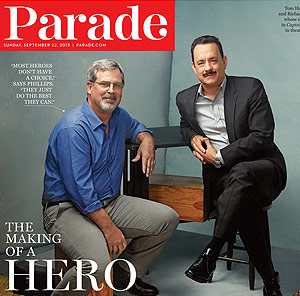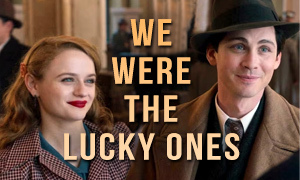Captain Phillips: History vs. Hollywood
based on the book "A Captain's Duty" by Richard Phillips
| REEL FACE: | REAL FACE: |
Tom Hanks
Born: July 9, 1956 Birthplace: Concord, California, USA | Captain Richard Phillips
Born: May 16, 1955 Birthplace: New Hampshire, USA |
Barkhad Abdi
Born: 1985 Birthplace: Galkayo, Mudug, Somalia | Abduwali Abdukhadir Muse
Born: c. 1990 Birthplace: Galkayo, Somalia |
Catherine Keener
Born: March 23, 1959 Birthplace: Miami, Florida, USA | Andrea Phillips
Born: April 16, 1957 Birthplace: Massachusetts, USA |
Michael Chernus
| Shane Murphy
Ship Rank: Captain (second in command) |
David Warshofsky
Born: February 23, 1961 Birthplace: San Francisco, California, USA | Mike Perry
Ship Rank: Chief Engineer |
Chris Mulkey
Born: May 3, 1948 Birthplace: Viroqua, Wisconsin, USA | John Cronan
Ship Rank: 3rd Engineer |
Corey Johnson
Born: May 17, 1961 Birthplace: New Orleans, Louisiana, USA | Ken Quinn
Ship Rank: 2nd Mate |
Where was the ship going when it was attacked?
Through our exploration into the Captain Phillips true story, we learned that the Maersk Alabama container ship had been on a voyage from Salalah, Oman to Mombasa, Kenya when it was attacked by Somali pirates on April 8, 2009. See a map of the ship's course further down this page.

The real Maersk Alabama container ship leaving its original destination of Mombasa, Kenya on April 21, 2009, eleven days after it had been attacked by Somalian pirates.
Was Captain Phillips conducting a security drill at the time of the pirate attack?
Not exactly. It was not a security drill. It was a fire drill. Knowing that the pirates were approaching by boat, Captain Phillips ordered that the yearly fire drill be completed anyway. "They [the boats] were seven miles away," says Phillips. "There was nothing we could do. We didn't know the exact situation." Certain members of the crew disagree, stating that they believe that the pirates were closer than seven miles and that the crew should have been going to their pirate stations. -New York Post
Did Captain Phillips really fake a call to the Navy to deter the pirate ships?
Yes. After observing the pirate boats headed his way, the real Captain Phillips used his radio to fake a call to the U.S. Navy. He disguised his voice to play the role of the Navy responder, hoping that the incoming pirates would overhear the communication and believe that assistance was on the way. It worked and the pirate mothership and two of its accompanying speedboats turned back (in the movie there is one less speedboat), leaving only one pirate speedboat in pursuit of the Alabama. -TIME.com
How many Somali pirates were involved in the hijacking?
When pitting the Captain Phillips true story vs. the movie, it was confirmed that four Somali pirates were involved in the hijacking of the Maersk Alabama, the same number shown in the movie.
Did they really use fire hoses in an effort to repel the pirates?
Yes. Like in the movie, the crew of the Maersk Alabama activated the ship's fire hoses. Captain Phillips fired flares at the pirates and the ship was steered so that it would sway back and forth. However, the pirates eventually still managed to throw up a ladder and board the ship, taking the bridge.
Did Captain Phillips lock the bridge before the pirates came aboard?
No. The movie opens with Captain Phillips meticulously attending to safety protocols, telling his crew, "Let's tighten up security! I want everything closed, locked, even in port." However, according to Chief Engineer Mike Perry, the real Captain Phillips didn't lock the bridge even when the attacking pirates were known to be on board. "Even at that point he didn't lock 'em," says Perry. Most of the crew members fled below deck and locked themselves in the engine room, remaining there for over twelve hours in 130 degree heat, while Phillips and three other crew members were held at gunpoint. -CNN
Did Captain Phillips really try to tell the pirates that the ship was broken?

A younger Richard Phillips in a 1979 Massachusetts Maritime Academy photo.
Did they really offer the pirates $30,000 from the ship's safe?
Yes. Like in the movie, the real Captain Richard Phillips and several crew members did try to offer the Somalian pirates $30,000 from the ship's safe, but they wanted much more. The pirates still took the money and had it with them when they fled the ship in the lifeboat. However, after the Navy shot the three Somalian pirates and boarded the lifeboat to rescue Captain Phillips, they found no trace of the $30,000. The money has never been recovered. -NavySEALs.com
Did the crew lay down broken glass as a trap for one of the pirates?
No. In the movie, the crew lays down broken glass inside the entrance to the engine room so that one of the pirates will step on it, injuring his bare feet. The injury forces the pirate to turn back, allowing the crew to overtake the other pirate with a knife and keep him as a hostage. In reality, the trap of broken glass never happened. Phillips also never led the pirates below deck to his crew's hiding place. Instead, he sent one of the crew members down to search the ship with one unarmed Somali pirate. Chief Engineer Mike Perry ambushed the pirate with a pocket knife and took him hostage.
Did the crew really take one of the pirates hostage?
Yes. When Somali pirate Abduwali Abdukhadir Muse was searching below deck, Chief Engineer Mike Perry fought with him in the dark of the engine room. Armed with a pocket knife, Perry subdued Muse, badly cutting the pirate's hand before taking him hostage.
Did Captain Phillips volunteer to sacrifice himself to save the lives of his crew?
No. "I didn't give myself up," says Captain Phillips. "I was already hostage." Unlike Tom Hanks's character in the movie, who yells to his fellow crew members, "I gotta get them off this ship!" as he willingly climbs into the Maersk Alabama's lifeboat, the real Captain Phillips never offered to give himself up for his crew. He was already a hostage. Like in the movie, Phillips says he went down to the lifeboat to help the pirates get it started. It was then that they reneged on their deal to release Phillips for Muse, keeping the Captain on board the lifeboat after the crew had released Abduwali Abdukhadir Muse. To that end, some of the crew members see Phillips as more the victim of a botched exchange, rather than the sacrificial hero that the media made him out to be.
"We vowed we were going to take it to our grave," says the Maersk Alabama's Chief Engineer Mike Perry. "We weren't going to say anything, and then we hear this PR stuff coming out about him giving himself up, and he's still hostage. The whole crew's like, 'What!?' Everybody's in shock." -CNN
Did Captain Phillips really say, "If you want to shoot somebody, shoot me!"?
No. The real Captain Richard Phillips never offered to give up his own life for his crew.
Do the crew members of the Maersk Alabama believe that Captain Phillips is a hero?
No, the majority of them do not believe that Captain Richard Phillips is a hero. In fact, due to the decisions made by Captain Phillips, 11 of the crew members have sued Maersk Line and the Waterman Steamship Corp. for nearly $50 million, citing "willful, wanton and conscious disregard for their safety." They believe that it is the Captain's recklessness that steered the Maersk Alabama into pirate infested waters. "All ships had been warned," says Chief Engineer Mike Perry, referring to a series of seven emails that had been sent to the Alabama by a private maritime security agency. The emails specifically warned of Somali pirate attacks in the area, stating, "...vessels should consider maintaining a distance of more than 600 nautical miles from Somalia coastline..." According to the Alabama's logs, the ship was only about 300 miles offshore. -CNN

The map above reveals the actual route (red) that Captain Phillips took from Salalah, Oman to Mombasa, Kenya vs. the suggested route (green). The yellow circle is the approximate location of the attack.
"Captain Phillips did not follow orders, the ship was attacked and he was responsible," says Jimmy Sabga, one of the crew members involved in the lawsuit against Maersk. -Business Insider
In a 2012 deposition that he gave for the lawsuit, Captain Phillips admitted he had read the email warnings. He also admitted that he had kept the warnings to himself. At the time that the hijacking was unfolding off of the Somali coast, his wife Andrea had even told an AP interviewer that she had received an email from her husband in which he said that pirate activity had been picking up in the area. When asked why he didn't move further offshore, Phillips testified, "I don't believe 600 miles would make you safe. I didn't believe 1,200 miles would make you safe. ... As I told the crew, it would be a matter of when, not if. So, we were always in this area, so it didn't, to me, lessen any potential." -CNN
It should be noted that Captain Phillips himself has said that he doesn't consider himself a hero, despite the media portraying him that way, his book being promoted that way, and the movie falsely depicting him offering himself up for his crew.
Did Phillips really try to escape by swimming from the lifeboat?

A US Navy Scan Eagle UAV (unmanned aerial vehicle) captures a photo of the Maersk Alabama's lifeboat on April 9, 2009 while Phillips was held hostage inside.
How many of the Somali pirates were killed?
Like in the movie, snipers from the Navy's famed SEAL Team Six used night-vision goggles to set their sights on the lifeboat and shoot three of the Somali pirates in the head almost simultaneously. The fourth, Abduwali Abdukhadir Muse, had come aboard the destroyer USS Bainbridge to seek medical attention for his badly cut hand and to negotiate the release of Captain Phillips. After his fellow pirates were killed, Muse remained on the Bainbridge and was taken into custody.
Did the real Richard Phillips write a note to his family while he was on the lifeboat?
No, this likely didn't happen. Phillips doesn't mention anything about writing a note to his family like Tom Hank's character does in the movie. However, he does mention praying for his family while he was on the lifeboat.
Did the pirates injure Captain Phillips?

Captain Richard Phillips waves to the crowd, revealing the scars on his wrist from where he had been tied up by pirates.
How long was Captain Richard Phillips held hostage on the lifeboat?
Although the movie makes it feel like Tom Hanks's character is only held hostage on the Maersk Alabama's lifeboat for about a day and a half, exploring the Captain Phillips true story reveals that the real Richard Phillips was held on the lifeboat for almost five days. He was rescued on Sunday, April 12, 2009 after having been on the lifeboat since Wednesday.
What happened to the captured Somali pirate?
Abduwali Abdukhadir Muse was tried as an adult in the U.S. and sentenced to thirty-three years in federal prison. His exact age became a controversial issue during the trial, with his family saying that he was under eighteen and should be tried as a juvenile. However, after giving different ages for himself, he eventually admitted that he was eighteen. According to his attorneys, while in custody, Muse has tried to commit suicide on a number of occasions. The director of a documentary about Muse, titled Smiling Pirate, says that Sony Pictures made several attempts to meet Muse but he declined, believing that they were just going to portray him as the bad guy.
Did Tom Hanks meet with the real Richard Phillips to prepare for the role?

Richard Phillips (left) poses with his onscreen counterpart, Tom Hanks (right), on the cover of the September 22, 2013 issue of Parade Magazine.
Did the Maersk Alabama's crew cooperate with the making of the movie?
Not all of the crew agreed with the movie's version of the story. The ones that were okay with it were paid as little as $5,000 by Sony for the rights to their story, with the agreement that they would never speak publicly to anyone else about what really happened on the ship. -New York Post
Was the real Maersk Alabama container ship used for the Captain Phillips movie?
No. The real Maersk Alabama ship was not used for the making of the movie. Instead, the filmmakers used the Alexander Maersk, a container ship that is identical to the Maersk Alabama. Filming took place off the coast of Malta in the Mediterranean Sea.
Captain Phillips Interviews and Related Video
See the real Captain Phillips speak to the press after returning to the U.S. following his rescue. Watch a CNN segment that addresses the controversy and then view the movie's trailer.
WATCH Captain Richard Phillips Rescue Press Conference on 4-17-2009Following his rescue and subsequent
journey back to the United States, the
real Captain Richard Phillips, who is the
basis for the 2013 Tom Hanks movie, speaks
to the press roughly twenty minutes after
touching down on U.S. soil at Burlington
International Airport in Burlington,
Vermont. His wife Andrea Phillips speaks
first and they both thank the Navy SEALs
and the crew of the USS
Bainbridge for their efforts in
getting Richard home safely. |
WATCH Captain Phillips Controversy InterviewIn this CNN segment, Drew Griffin reports
on the allegations made by former crew
members, including the Maersk
Alabama's Chief Engineer Mike Perry,
who claim Richard Phillips was reckless
and not a hero. The lawsuit filed by some
of the crew members against the shipping
company is addressed, in addition to the
pirate warnings that the Captain ignored
and kept to himself. |
WATCH Captain Phillips TrailerDirected by Paul Greengrass and starring
Tom Hanks in the title role, Captain
Phillips tells the true story of the
2009 hijacking of the cargo ship
Maersk Alabama by Somali Pirates.
The biopic is based on these events in the
life of Captain Richard Phillips, as
conveyed in his book A Captain's Duty:
Somali Pirates, Navy SEALs, and Dangerous
Days at Sea. This is the second
Captain Phillips movie trailer. |
Link-to-Learn More:







